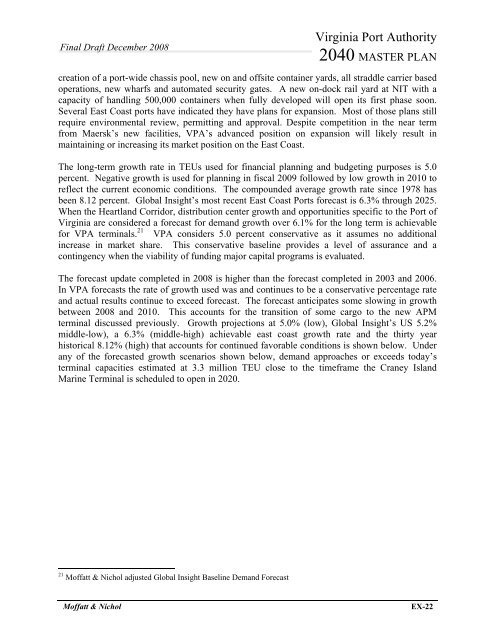VPA 2040 Master Plan Executive Summary - The Port of Virginia
VPA 2040 Master Plan Executive Summary - The Port of Virginia
VPA 2040 Master Plan Executive Summary - The Port of Virginia
You also want an ePaper? Increase the reach of your titles
YUMPU automatically turns print PDFs into web optimized ePapers that Google loves.
Final Draft December 2008<br />
<strong>Virginia</strong> <strong>Port</strong> Authority<br />
<strong>2040</strong> MASTER PLAN<br />
creation <strong>of</strong> a port-wide chassis pool, new on and <strong>of</strong>fsite container yards, all straddle carrier based<br />
operations, new wharfs and automated security gates. A new on-dock rail yard at NIT with a<br />
capacity <strong>of</strong> handling 500,000 containers when fully developed will open its first phase soon.<br />
Several East Coast ports have indicated they have plans for expansion. Most <strong>of</strong> those plans still<br />
require environmental review, permitting and approval. Despite competition in the near term<br />
from Maersk’s new facilities, <strong>VPA</strong>’s advanced position on expansion will likely result in<br />
maintaining or increasing its market position on the East Coast.<br />
<strong>The</strong> long-term growth rate in TEUs used for financial planning and budgeting purposes is 5.0<br />
percent. Negative growth is used for planning in fiscal 2009 followed by low growth in 2010 to<br />
reflect the current economic conditions. <strong>The</strong> compounded average growth rate since 1978 has<br />
been 8.12 percent. Global Insight’s most recent East Coast <strong>Port</strong>s forecast is 6.3% through 2025.<br />
When the Heartland Corridor, distribution center growth and opportunities specific to the <strong>Port</strong> <strong>of</strong><br />
<strong>Virginia</strong> are considered a forecast for demand growth over 6.1% for the long term is achievable<br />
for <strong>VPA</strong> terminals. 21 <strong>VPA</strong> considers 5.0 percent conservative as it assumes no additional<br />
increase in market share. This conservative baseline provides a level <strong>of</strong> assurance and a<br />
contingency when the viability <strong>of</strong> funding major capital programs is evaluated.<br />
<strong>The</strong> forecast update completed in 2008 is higher than the forecast completed in 2003 and 2006.<br />
In <strong>VPA</strong> forecasts the rate <strong>of</strong> growth used was and continues to be a conservative percentage rate<br />
and actual results continue to exceed forecast. <strong>The</strong> forecast anticipates some slowing in growth<br />
between 2008 and 2010. This accounts for the transition <strong>of</strong> some cargo to the new APM<br />
terminal discussed previously. Growth projections at 5.0% (low), Global Insight’s US 5.2%<br />
middle-low), a 6.3% (middle-high) achievable east coast growth rate and the thirty year<br />
historical 8.12% (high) that accounts for continued favorable conditions is shown below. Under<br />
any <strong>of</strong> the forecasted growth scenarios shown below, demand approaches or exceeds today’s<br />
terminal capacities estimated at 3.3 million TEU close to the timeframe the Craney Island<br />
Marine Terminal is scheduled to open in 2020.<br />
21 M<strong>of</strong>fatt & Nichol adjusted Global Insight Baseline Demand Forecast<br />
M<strong>of</strong>fatt & Nichol EX-22


